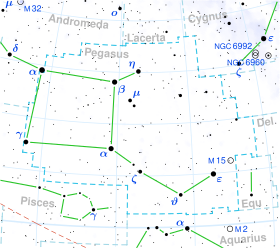| Observation data Epoch J2000 Equinox J2000 | |
|---|---|
| Constellation | Pegasus |
| Right ascension | 21h 22m 05.19950s [1] |
| Declination | 19° 48′ 16.2375″ [1] |
| Apparent magnitude (V) | 4.09[2] |
| Characteristics | |
| Spectral type | K1III[3] |
| U−B color index | +1.05[2] |
| B−V color index | +1.11[2] |
| Astrometry | |
| Radial velocity (Rv) | −10.80[4] km/s |
| Proper motion (μ) | RA: +105.391 mas/yr[1] Dec.: +62.841 mas/yr[1] |
| Parallax (π) | 20.8482 ± 0.1452 mas[1] |
| Distance | 156 ± 1 ly (48.0 ± 0.3 pc) |
| Absolute magnitude (MV) | 0.68[5] |
| Details[6] | |
| 1 Peg A | |
| Mass | 1.60±0.18 M☉ |
| Radius | 11.89±0.15 R☉ |
| Luminosity | 63.5±0.3 L☉ |
| Surface gravity (log g) | 2.59[7] cgs |
| Temperature | 4,725±64 K |
| Metallicity [Fe/H] | +0.01[7] dex |
| Rotational velocity (v sin i) | 1.2[8] km/s |
| Age | 1.60±0.18 Gyr |
| Other designations | |
| Database references | |
| SIMBAD | data |
1 Pegasi (1 Peg) is a triple star[10] system in the constellation Pegasus, located approximately 156 light years away from the Sun based on parallax.[1] It is visible to the naked eye as a faint, orange-hued star with an apparent visual magnitude of 4.09.[2] The system is moving closer to the Earth with a heliocentric radial velocity of −11 km/s.[4]
The primary component is a giant with a stellar classification of K1III,[3] a star that has exhausted the hydrogen supply at its core and evolved away from the main sequence. Estimated to be 1.6 billion years old, 1 Pegasi has 1.6 times the mass of the Sun and has expanded to twelve times the Sun's radius. The star is radiating 64 times the Sun's luminosity from its enlarged photosphere at an effective temperature of 4,725 K.[6]
There are several companions in addition to the primary. The brightest, component B, is a magnitude 9.3, K-type main-sequence star with a class of K0 V orbiting at an angular separation of 36.6" from the primary; it is itself a single-lined spectroscopic binary with an orbital period of 3.042 ± 0.011 years and eccentricity of 0.290±0.022.[11] Visual companions C, with magnitude 12.9 and separation 64.7", and D, with magnitude 9.6 and separation 5.3", have been reported.[12]
- ^ a b c d e Cite error: The named reference
DR3was invoked but never defined (see the help page). - ^ a b c d Ducati, J. R. (2002). "VizieR Online Data Catalog: Catalogue of Stellar Photometry in Johnson's 11-color system". CDS/ADC Collection of Electronic Catalogues. 2237. Bibcode:2002yCat.2237....0D.
- ^ a b Hoffleit, D.; Warren, W. H. (1995). "VizieR Online Data Catalog: Bright Star Catalogue, 5th Revised Ed. (Hoffleit+, 1991)". VizieR On-line Data Catalog: V/50. Originally Published in: 1964BS....C......0H. 5050. Bibcode:1995yCat.5050....0H.
- ^ a b Bakos, G. A. (1974). "Radial velocity measurements of visual binaries. 1". The Astronomical Journal. 79: 866. Bibcode:1974AJ.....79..866B. doi:10.1086/111622.
- ^ Anderson, E.; Francis, Ch. (2012). "XHIP: An extended hipparcos compilation". Astronomy Letters. 38 (5): 331. arXiv:1108.4971. Bibcode:2012AstL...38..331A. doi:10.1134/S1063773712050015. S2CID 119257644. Vizier catalog entry
- ^ a b Cite error: The named reference
baines2018was invoked but never defined (see the help page). - ^ a b Wu, Yue; Singh, H. P.; Prugniel, P.; Gupta, R.; Koleva, M. (2010). "Coudé-feed stellar spectral library – atmospheric parameters". Astronomy & Astrophysics. 525: A71. arXiv:1009.1491. Bibcode:2011A&A...525A..71W. doi:10.1051/0004-6361/201015014. S2CID 53480665.
- ^ De Medeiros, J. R.; Mayor, M. (1999). "A catalog of rotational and radial velocities for evolved stars". Astronomy and Astrophysics Supplement Series. 139 (3): 433. arXiv:astro-ph/0608248. Bibcode:1999A&AS..139..433D. doi:10.1051/aas:1999401. Vizier catalog entry
- ^ "1 Peg". SIMBAD. Centre de données astronomiques de Strasbourg. Retrieved 2019-04-10.
- ^ Eggleton, P. P.; Tokovinin, A. A. (2008). "A catalogue of multiplicity among bright stellar systems". Monthly Notices of the Royal Astronomical Society. 389 (2): 869. arXiv:0806.2878. Bibcode:2008MNRAS.389..869E. doi:10.1111/j.1365-2966.2008.13596.x. S2CID 14878976. Vizier catalog entry
- ^ Griffin, R. F. (February 1987). "Spectroscopic binary orbits from photoelectric radial velocities. Paper 72: 1 Pegasi B". The Observatory. 107: 1–5. Bibcode:1987Obs...107....1G.
- ^ Mason, Brian D.; Wycoff, Gary L.; Hartkopf, William I.; Douglass, Geoffrey G.; Worley, Charles E. (2001). "The 2001 US Naval Observatory Double Star CD-ROM. I. The Washington Double Star Catalog". The Astronomical Journal. 122 (6): 3466. Bibcode:2001AJ....122.3466M. doi:10.1086/323920. Vizier catalog entry
